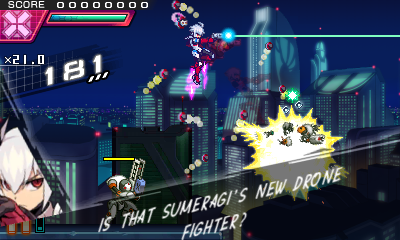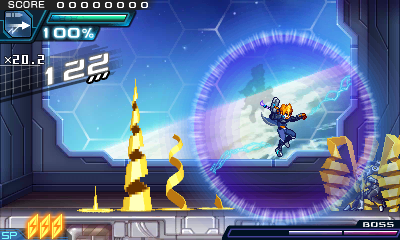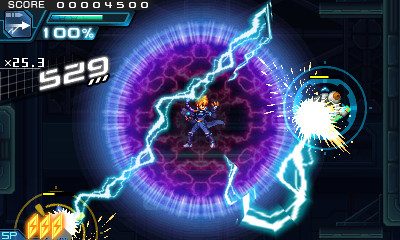 |
|
|---|---|
| Title | Azure Striker Gunvolt 2 |
| Developer | Inti Creates |
| Publisher | Inti Creates, Yacht Club Games (Striker Pack) |
| Release Date | September 29th, 2016 |
| Genre | Action Platformer |
| Platform | Nintendo 3DS |
| Age Rating | T for Teen – Fantasy Violence, Mild Blood, Mild Language, Suggestive Themes |
| Official Website | |
Two years ago, we were all introduced to the world of Azure Striker Gunvolt, a fascinating and vibrant world of Adepts, Septima and all manner of scheming. While the similarities to the Mega Man series are somewhat unavoidable, not least of all thanks the efforts of Keiji Inafune, the first game did a good job of distinguishing itself while still laying the groundwork for its own unique and satisfying experience. Now that the sequel is here, with not only one, but two playable characters, the question is: does Azure Striker Gunvolt 2 improve on the original, or is it just a faded reflection of the first game?
Azure Striker Gunvolt 2 picks up a short while after the events of the first game. Joule now resides in incorporeal form inside Gunvolt, and she has grown a bit more spunky in her time without a body. Things get hectic when a mysterious group called Eden takes control of an airship. Gunvolt does his usual heroic thing and steps up, but things quickly get more complicated with the appearance of his rival, Copen. Relegated to an intense boss fight in the original game, this time around Copen is a fully playable character. You are introduced to his play style in the intro stage as his sister, Mytyl, has been kidnapped and is aboard the flying ship along with Gunvolt. Unaware of this fact, Copen and his ACP Lola blaze a path of destruction using his swank new gear, which allows him to fly like an eagle and rain destruction on anything nearby. Copen and Gunvolt are forced into an uncomfortable reunion as a blast from the past appears, and things quickly get much more complicated. Cue Joule’s essence getting imprisoned and shattered into several pieces, which are then carried away by Eden’s elite, The Seven. They are incredibly powerful Adepts armed with Grimoires which, unlike Glaives from the previous game, allow them a host of powerful new enhancements. From that point on, you are given the opportunity to select Gunvolt or Copen to play as, and that’s where the fun really begins.
Regardless of who you choose, the game boasts several stages which culminate in a final assault on Eden’s headquarters, The Garden. Just like in the last game, you select the order you play them in, followed by stages you have to play in sequence. What I appreciated about this formula was how the stages and bosses you played varied depending on who you played as. For example, one stage that is exclusive to Gunvolt is the Mysterious Manor. This fantastic stage could have been ripped straight out of a Castlevania game, as it has lots of breakable stained glass, dangerous spikes and even “zombies”. The boss of that stage, Gibril, was a fascinating Adept who manipulated metal and blood to attack you, transforming into different forms and summoning Iron Maidens to devour you. For Copen, one of my favorite exclusive stages was the orbital tower known as Babel. This vertical wonder made great use of Copen’s new flight skills, as you were encouraged to lock onto floating enemies to get around instead of walking on crumbling platforms or strands of hair. Yes, you heard that last part right. The boss of Babel is a beautiful Adept named Desna, and her Septima allows her to use her long golden locks any way she wants, including as a weapon. Besides these exclusive stages, there are also a handful that get used for both characters, but the variety was enough to keep things interesting. I will say that Copen’s stages overall felt more diverse and energetic.
Gameplay is still centered around the unique tagging mechanic. Gunvolt does this with darts fired from his gun, while Copen does so by bodily dashing into foes. Though both characters do share some things in common, such as having access to flashy skills and gaining weapons from bosses, they couldn’t play more differently. Gunvolt is a more patient and cautious fighter, tagging from a safe distance and hovering over foes with his electromagnetism, while Copen is a furious fighter, getting up close and personal and ripping enemies to shreds with the help of Lola. Lola absorbs the powers of fallen Adepts and can then utilize them as EX skills to aid Copen. For example, using Desna’s skills Lola can shoot forth two spikes of golden hair, or using Asroc’s skills shoots forth discs that tangle up foes. This is on top of Copen’s others attacks, so it may seem that Copen is totally overpowered. After all, Gunvolt only gets new dart types from bosses, not entirely new abilities. However, one of the ways that the game compensates for this is by giving Copen some really challenging exclusive stages. The other way is with the use of the new Kudos system.
I can honestly say that, while I loved the original Azure Striker Gunvolt, the Kudos system there drove me totally nuts. It gave you points every time you defeated a foe, and if you could keep doing it in succession, you got rewarded with multipliers, which then resulted in your score at the end of stages. It sounds good, except for one caveat; get hit once, and your points reset. I found that more than a little unfair since it penalized us for not being perfect, but luckily that system has been improved in Gunvolt 2. Now you can choose what type of Kudos to use. If you’re feeling Gutless, you can make it so Kudos never reset, at the cost of getting less points. You can also go Fearless so that one hit resets your points. My favorite option, however, was the Cautious route, which let you get hit 3 times before your points reset. Better yet, getting to a checkpoint saves your current points, so you are able to accumulate Kudos for the duration of each stage.








